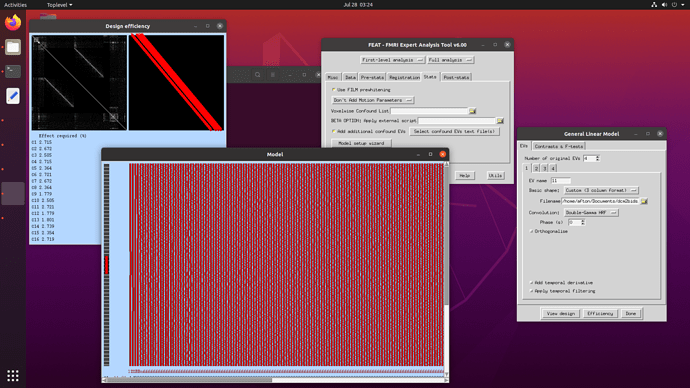I am running my analysis in FSL FEAT (preprocessing-fmriprep, spatial smooth-FSLmaths) and have all aspects input accordingly for the event files (not sure what details I should include here to be helpful). I go to run the analysis and get an error in “preprocess stage 2” according to the log file.
Below is the extent of the report and the error:
Feat main script
/bin/cp /tmp/feat_BJJ3Z0.fsf design.fsf
/usr/local/fsl/bin/feat_model design
mkdir .files;cp /usr/local/fsl/doc/fsl.css .files;cp -r /usr/local/fsl/doc/images .files/images
/usr/local/fsl/bin/fsl_sub -T 10 -l logs -N feat0_init /usr/local/fsl/bin/feat /home/afton/Documents/dcm2bids_P10_test/derivatives/fsl_first-level.feat/design.fsf -D /home/afton/Documents/dcm2bids_P10_test/derivatives/fsl_first-level.feat -I 1 -init
9014
/usr/local/fsl/bin/fsl_sub -T 0 -l logs -N feat2_pre -j 9014 /usr/local/fsl/bin/feat /home/afton/Documents/dcm2bids_P10_test/derivatives/fsl_first-level.feat/design.fsf -D /home/afton/Documents/dcm2bids_P10_test/derivatives/fsl_first-level.feat -I 1 -prestats
9462
/usr/local/fsl/bin/fsl_sub -T 65 -l logs -N feat3_film -j 9462 /usr/local/fsl/bin/feat /home/afton/Documents/dcm2bids_P10_test/derivatives/fsl_first-level.feat/design.fsf -D /home/afton/Documents/dcm2bids_P10_test/derivatives/fsl_first-level.feat -I 1 -stats
child process exited abnormally
while executing
"if { [ catch {
for { set argindex 1 } { $argindex < $argc } { incr argindex 1 } {
switch -- [ lindex $argv $argindex ] {
-I {
incr arginde..."
(file "/usr/local/fsl/bin/feat" line 312)
FATAL ERROR ENCOUNTERED:
COMMAND:
/usr/local/fsl/bin/fsl_sub -T 65 -l logs -N feat3_film -j 9462 /usr/local/fsl/bin/feat /home/afton/Documents/dcm2bids_P10_test/derivatives/fsl_first-level.feat/design.fsf -D /home/afton/Documents/dcm2bids_P10_test/derivatives/fsl_first-level.feat -I 1 -stats
ERROR MESSAGE:
child process exited abnormally
END OF ERROR MESSAGE
I do not find that the error message is very specific and have not found others with the same error. Would anyone have any ideas? Happy to include more information where it would be helpful!
